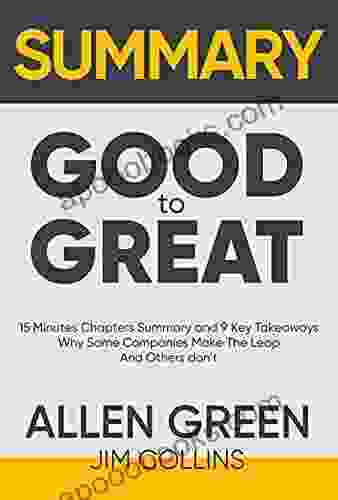15 Minutes Chapters Summary And Key Takeaways: Why Some Companies Make The Leap

In his book '15 Minutes', Roger Martin argues that the key to success in today's fast-paced business environment is the ability to make quick decisions. He identifies five key capabilities that companies need to develop in Free Download to achieve this: 1) The ability to see around corners; 2) The ability to make quick decisions; 3) The ability to take action quickly; 4) The ability to learn from mistakes; and 5) The ability to adapt quickly.
4.1 out of 5
| Language | : | English |
| File size | : | 399 KB |
| Text-to-Speech | : | Enabled |
| Screen Reader | : | Supported |
| Enhanced typesetting | : | Enabled |
| Print length | : | 14 pages |
| Lending | : | Enabled |
Martin provides numerous examples of companies that have successfully implemented these capabilities, and he offers a roadmap for how other companies can do the same. In this article, we will summarize the key takeaways from each chapter of '15 Minutes' and provide our own insights on how you can apply these principles to your own business.
Chapter 1: See Around Corners
In the first chapter of '15 Minutes', Martin argues that the ability to see around corners is essential for making quick decisions. He defines "cornering" as the ability to anticipate future events and trends. Companies that can see around corners are able to make better decisions today because they have a clearer understanding of what the future holds.
Martin identifies three key elements of cornering: 1) Pattern recognition: The ability to identify patterns in data and events; 2) Hypothesis generation: The ability to generate testable hypotheses about the future; and 3) Scenario planning: The ability to develop multiple scenarios for the future and evaluate their implications.
Companies that are good at cornering are able to develop a "peripheral vision" that allows them to see opportunities and threats that others miss. They are also able to make decisions quickly and decisively because they have a clear understanding of the risks and rewards involved.
Chapter 2: Make Quick Decisions
In the second chapter of '15 Minutes', Martin argues that the ability to make quick decisions is essential for success in today's fast-paced business environment. He points out that the average lifespan of a company is now only 15 years, which is down from 50 years in the 1950s.
Martin identifies three key elements of quick decision-making: 1) Trusting your instincts: The ability to rely on your own judgment and make decisions without overanalyzing; 2) Delegating authority: The ability to empower your team to make decisions on their own; and 3) Using data to inform decisions: The ability to use data to support your decisions and avoid making emotional mistakes.
Companies that are good at making quick decisions are able to respond to changes in the market more quickly than their competitors. They are also able to take advantage of opportunities that others miss.
Chapter 3: Take Action Quickly
In the third chapter of '15 Minutes', Martin argues that the ability to take action quickly is essential for success in today's fast-paced business environment. He points out that the speed of execution is often more important than the quality of the decision.
Martin identifies three key elements of taking action quickly: 1) Setting clear goals: The ability to set clear goals and objectives for your team; 2) Breaking down tasks into smaller steps: The ability to break down large projects into smaller, more manageable tasks; and 3) Removing roadblocks: The ability to identify and remove any obstacles that are preventing your team from taking action.
Companies that are good at taking action quickly are able to implement their decisions more quickly than their competitors. They are also able to learn from their mistakes more quickly and make adjustments as needed.
Chapter 4: Learn From Mistakes
In the fourth chapter of '15 Minutes', Martin argues that the ability to learn from mistakes is essential for success in today's fast-paced business environment. He points out that mistakes are inevitable, and the key is to learn from them and avoid repeating them in the future.
Martin identifies three key elements of learning from mistakes: 1) Admitting mistakes: The ability to admit when you have made a mistake; 2) Analyzing mistakes: The ability to analyze your mistakes to identify the root causes; and 3) Taking corrective action: The ability to take corrective action to prevent the mistake from happening again.
Companies that are good at learning from mistakes are able to avoid repeating the same mistakes over and over again. They are also able to use their mistakes to improve their products and services.
Chapter 5: Adapt Quickly
In the fifth and final chapter of '15 Minutes', Martin argues that the ability to adapt quickly is essential for success in today's fast-paced business environment. He points out that the world is changing more quickly than ever before, and companies need to be able to adapt to these changes in Free Download to survive.
Martin identifies three key elements of adapting quickly: 1) Being open to new ideas: The ability to be open to new ideas and ways of ng things; 2) Experimenting with new approaches: The ability to experiment with new approaches to find the best way to do things; and 3) Learning from your experiments: The ability to learn from your experiments and make adjustments as needed.
Companies that are good at adapting quickly are able to respond to changes in the market more quickly than their competitors. They are also able to take advantage of new opportunities that others miss.
In his book '15 Minutes', Roger Martin provides a roadmap for how companies can achieve success in today's fast-paced business environment. He identifies five key capabilities that companies need to develop: 1) The ability to see around corners; 2) The ability to make quick decisions; 3) The ability to take action quickly; 4) The ability to learn from mistakes; and 5) The ability to adapt quickly.
By following the principles outlined in '15 Minutes', companies can improve their decision-making, execution, and innovation capabilities. This will allow them to respond to changes in the market more quickly and effectively, and ultimately achieve greater success.
4.1 out of 5
| Language | : | English |
| File size | : | 399 KB |
| Text-to-Speech | : | Enabled |
| Screen Reader | : | Supported |
| Enhanced typesetting | : | Enabled |
| Print length | : | 14 pages |
| Lending | : | Enabled |
Do you want to contribute by writing guest posts on this blog?
Please contact us and send us a resume of previous articles that you have written.
 Book
Book Novel
Novel Page
Page Chapter
Chapter Text
Text Story
Story Genre
Genre Reader
Reader Library
Library Paperback
Paperback E-book
E-book Magazine
Magazine Newspaper
Newspaper Paragraph
Paragraph Sentence
Sentence Bookmark
Bookmark Shelf
Shelf Glossary
Glossary Bibliography
Bibliography Foreword
Foreword Preface
Preface Synopsis
Synopsis Annotation
Annotation Footnote
Footnote Manuscript
Manuscript Scroll
Scroll Codex
Codex Tome
Tome Bestseller
Bestseller Classics
Classics Library card
Library card Narrative
Narrative Biography
Biography Autobiography
Autobiography Memoir
Memoir Reference
Reference Encyclopedia
Encyclopedia Richard M Knittle Jr
Richard M Knittle Jr Tom Bower
Tom Bower Robert Klane
Robert Klane Jeannine Colette
Jeannine Colette Shawna Wingert
Shawna Wingert Suzanne Schneider
Suzanne Schneider Tim Alan Garrison
Tim Alan Garrison Ryan Michele
Ryan Michele Tessa Layne
Tessa Layne Fiona Quinn
Fiona Quinn Stuart Grosse
Stuart Grosse Joseph Stone
Joseph Stone Sandie Jones
Sandie Jones Stephen Mark Rainey
Stephen Mark Rainey Roberto Galli
Roberto Galli Steve Kluger
Steve Kluger Thomas Dorsch
Thomas Dorsch Viktor Vagon
Viktor Vagon George Perkins
George Perkins Indu Sundaresan
Indu Sundaresan
Light bulbAdvertise smarter! Our strategic ad space ensures maximum exposure. Reserve your spot today!

 Dylan MitchellManaging Fraud and Corruption Risk in Local Government: A Comprehensive Guide
Dylan MitchellManaging Fraud and Corruption Risk in Local Government: A Comprehensive Guide
 Jerry HayesBlind Pass: The Unstoppable Journey of Teagan Hunter, the Visually Impaired...
Jerry HayesBlind Pass: The Unstoppable Journey of Teagan Hunter, the Visually Impaired...
 Maurice ParkerIntroducing the Red Doily Purse Bag Crochet Pattern: A Must-Have for Every...
Maurice ParkerIntroducing the Red Doily Purse Bag Crochet Pattern: A Must-Have for Every... Jayden CoxFollow ·6.7k
Jayden CoxFollow ·6.7k Guillermo BlairFollow ·18.1k
Guillermo BlairFollow ·18.1k Jack LondonFollow ·12.9k
Jack LondonFollow ·12.9k Roy BellFollow ·10.5k
Roy BellFollow ·10.5k Herman MelvilleFollow ·18.3k
Herman MelvilleFollow ·18.3k Clayton HayesFollow ·13.7k
Clayton HayesFollow ·13.7k Charles DickensFollow ·3.9k
Charles DickensFollow ·3.9k Eric NelsonFollow ·7.6k
Eric NelsonFollow ·7.6k

 Harry Cook
Harry CookRape Blossoms and White Sky: A Floral Symphony of...
A Kaleidoscope of Colors...

 Vic Parker
Vic ParkerThe Passion of Jovita Fuentes: Unveiling the...
Immerse yourself in the...

 Cormac McCarthy
Cormac McCarthySinners and Saints: A Dark New Adult High School Bully...
Sinners and Saints is...
4.1 out of 5
| Language | : | English |
| File size | : | 399 KB |
| Text-to-Speech | : | Enabled |
| Screen Reader | : | Supported |
| Enhanced typesetting | : | Enabled |
| Print length | : | 14 pages |
| Lending | : | Enabled |










